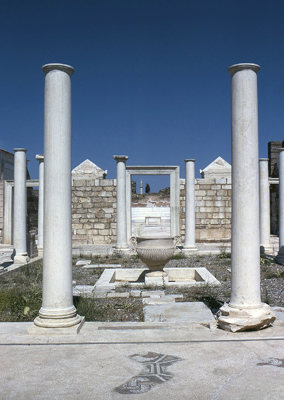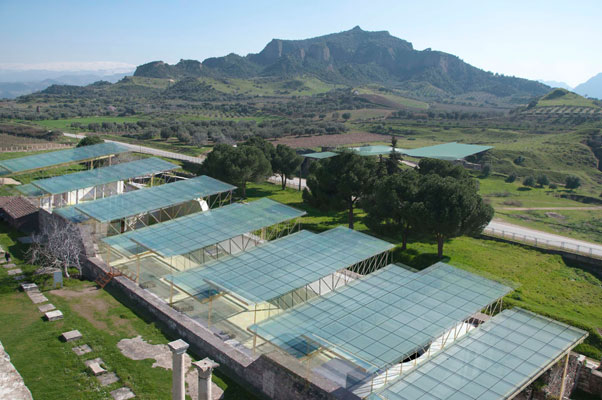The Harvard Art Museums’ glass roof gets plenty of attention—and deservedly so. Now, two new glass roofs are being planned at the museums’ Archaeological Exploration of Sardis, in western Turkey.
Since 1958, the Harvard Art Museums and Cornell University have organized the annual archaeological expedition. The city of Sardis was the capital of the Lydian empire from the 8th to the 6th century BCE, and remained a powerful urban center until the 7th century CE. Decades of collaborative research have yielded many important finds, including the largest extant synagogue of antiquity; the temple of Artemis, the fourth-largest Ionic temple in the world; and a major Roman triumphal arch, discovered last summer.
Now, amid ongoing excavation and conservation work and a recent boom in tourism to Sardis, plans are under way to erect glass roofs above the synagogue and a section of the Lydian fortification, which dates to the 7th century BCE. The roofs will help protect the sites from the elements, and the translucent glass will offer diffuse light to help cool the spaces underneath, particularly on hot days.
The synagogue, discovered in 1962, was built in late antiquity (4th and 5th centuries CE), as part of the city’s public bath-gymnasium. Its main assembly hall measures almost 200 feet long, large enough to hold nearly a thousand people. It is paved with a mosaic floor and decorated with sculptures, a fountain, and inlaid marble panels—indications of grandeur that speak to the size and influence of Sardis’s Jewish population in that period.
Soon after the discovery of the hall, conservators lifted the mosaics from the floor and reset them on new concrete slabs. Over the years since that restoration, however, weathering had damaged the concrete, and the mosaics were in danger of being irreparably harmed.
Conservators have recently stabilized and preserved the mosaics, thanks to support from the JM Kaplan Fund. Today, they’re in “quite good shape,” said Nicholas Cahill, director of the Archaeological Exploration of Sardis, and professor of art history at the University of Wisconsin-Madison. But all that care makes it “imperative that we take advantage of their good condition and protect them now while we can. It was the impetus for deciding to roof the synagogue.”
The other new glass roof at Sardis will shield a 100-foot section of the site’s Lydian fortification. This is the best-preserved segment of the fortification, and the most extensively excavated thus far. It’s also a thousand years older than the synagogue. A combination of mud brick, fired bricks, and stone masonry comprise the entire fortification, which is 65 feet thick and stands more than 40 feet tall in some places—probably only half its original height. “It’s got to be one of the largest single structures in Turkey,” Cahill said. “It’s unlike anything else in this part of the world.”
Since it is made in part from unbaked clay mud bricks (or adobe), the fortification is extremely fragile. “If you leave it in rain, it just washes away,” Cahill said. While there currently is a roof over some remains adjacent to the fortification, that roof was built in the 1990s; its polycarbonate panels have begun to fail and must be replaced. The proposed new glass roof would not only last longer but also offer more functionality; it includes multiple levels of roofs, and visitor platforms would offer different vantage points, including a panoramic view of the entire ancient city.
Although the projects are still in the fundraising phase, much of the planning is already complete. Architects Troy Thompson, vice president of Washington, D.C.–based SmithGroup JJR, Philip Stinson of the University of Kansas, and Nathaniel Schlundt designed the structures pro bono, with the help of Brianna Bricker of the University of California, Santa Barbara.
The Archaeological Exploration of Sardis is undertaking another major initiative: to have Sardis recognized as a UNESCO World Heritage Site. Sardis was recently added to Turkey’s list of potential nominees for the honor. In the coming years, the Sardis team will assist Turkey with the intensive application process.
The addition of the roofs will surely help bring even more attention to Sardis and enhance its role as an educational site and an economic booster to the region.
To learn more about Sardis and its latest discoveries, don’t miss the March 25 lecture at the museums by Nicholas Cahill, “New Digs and Discoveries at Sardis in Turkey.”



